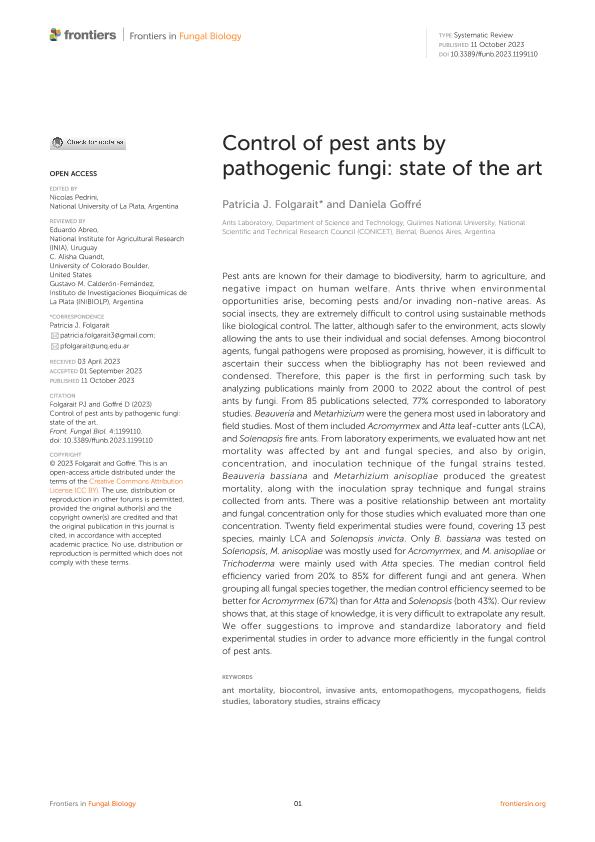Artículo
Control of pest ants by pathogenic fungi: State of the art
Fecha de publicación:
10/2023
Editorial:
Frontiers Media
Revista:
Frontiers in Fungal Biology
e-ISSN:
2673-6128
Idioma:
Inglés
Tipo de recurso:
Artículo publicado
Clasificación temática:
Resumen
Pest ants are known for their damage to biodiversity, harm to agriculture, and negative impact on human welfare. Ants thrive when environmental opportunities arise, becoming pests and/or invading non-native areas. As social insects, they are extremely difficult to control using sustainable methods like biological control. The latter, although safer to the environment, acts slowly allowing the ants to use their individual and social defenses. Among biocontrol agents, fungal pathogens were proposed as promising, however, it is difficult to ascertain their success when the bibliography has not been reviewed and condensed. Therefore, this paper is the first in performing such task by analyzing publications mainly from 2000 to 2022 about the control of pest ants by fungi. From 85 publications selected, 77% corresponded to laboratory studies. Beauveria and Metarhizium were the genera most used in laboratory and field studies. Most of them included Acromyrmex and Atta leaf-cutter ants (LCA), and Solenopsis fire ants. From laboratory experiments, we evaluated how ant net mortality was affected by ant and fungal species, and also by origin, concentration, and inoculation technique of the fungal strains tested. Beauveria bassiana and Metarhizium anisopliae produced the greatest mortality, along with the inoculation spray technique and fungal strains collected from ants. There was a positive relationship between ant mortality and fungal concentration only for those studies which evaluated more than one concentration. Twenty field experimental studies were found, covering 13 pest species, mainly LCA and Solenopsis invicta. Only B. bassiana was tested on Solenopsis, M. anisopliae was mostly used for Acromyrmex, and M. anisopliae or Trichoderma were mainly used with Atta species. The median control field efficiency varied from 20% to 85% for different fungi and ant genera. When grouping all fungal species together, the median control efficiency seemed to be better for Acromyrmex (67%) than for Atta and Solenopsis (both 43%). Our review shows that, at this stage of knowledge, it is very difficult to extrapolate any result. We offer suggestions to improve and standardize laboratory and field experimental studies in order to advance more efficiently in the fungal control of pest ants.
Archivos asociados
Licencia
Identificadores
Colecciones
Articulos(SEDE CENTRAL)
Articulos de SEDE CENTRAL
Articulos de SEDE CENTRAL
Citación
Folgarait, Patricia Julia; Goffré, Daniela; Control of pest ants by pathogenic fungi: State of the art; Frontiers Media; Frontiers in Fungal Biology; 4; 1199110; 10-2023; 1-20
Compartir
Altmétricas




